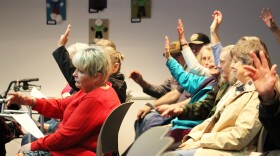There’s less than a week to go until residents from around Alaska descend on Kenai to participate in the city’s personal use salmon fishery. The annual sockeye harvest for Alaska residents is open July 10 through the end of the month.
Last year, the City of Kenai took in almost half a million dollars through its personal use fishery. Although the fishery is regulated by the Alaska Department of Fish and Game, it’s supported by the city. Dipnetters accessing the mouth of the Kenai River make heavy use of the city’s north and south beaches. Those in boats head for the city dock off Bridge Access Road.
Much of the annual prep and maintenance work falls to Kenai’s Parks and Recreation Department. That’s headed by Tyler Best. During the city’s annual budget work session, held in May, he summarized last year’s season, noting most dipnetters aren’t from Kenai.
“82% of our participants are from outside the Kenai Peninsula, 50% come from Anchorage, 15% come from the Mat-Su Valley and then 7% of them do have a local Kenai zip code,” he said.
Last year, Alaskans brought home more than 325,000 sockeye salmon through Kenai’s personal use fishery. That’s as compared to the fishery in Kasilof, where roughly half that number of fish were caught during the same season.
To accommodate the influx of fishers, Kenai has a special fund for its personal use fishery operations [WEB: called the Personal Use Fishery Fund]. The account exists independently of the city’s general fund and from its other special revenue funds. It’s where money from the fishery is deposited, and from which the fishery’s expenses are paid.
Each year, Kenai hires seasonal staff, brings in extra restrooms and ups its law enforcement presence with seasonal officers. Here’s Best again.
“We hire 15 seasonal people for the PU fishery that kind of runs our shacks and keeps the dock and the North Beach clean,” he said. “That consists of eight cashiers, seven attendants.”
Going into the personal use fishery account is money the city gets from its fishery fees, like beach camping, parking and use of the city dock.
During the same May work session, Kenai Finance Director David Swarner said the account tends to break even.
“This is another program that is really no cost to the taxpayers,” he said. “It pretty well funds itself.”
Last year, the amount of money generated for Kenai by the fishery increased slightly from the year prior. That’s according to the city’s annual report summarizing how the fishery went. The city also increased fees that year, by five percent. It was the second half of the city’s plan to increase fees overall by 10% across a two-year period.
This year, the city’s charging about $22 for day use parking and between $50 and $60 for overnight parking at its beach and overflow sites. Beach camping costs about $28 per night and boat launching and parking from the city dock will run users about $40.
Kenai’s personal-use salmon fishery opens July 10 and will end on July 31. The fishery is open between 6 a.m. and 10 p.m. for Alaska residents. Permits are required and the catch limit is based on household size. Detailed information about the fishery can be found on the City of Kenai’s website at kenai.city and on the Alaska Department of Fish and Game website at adfg.alaska.gov.







